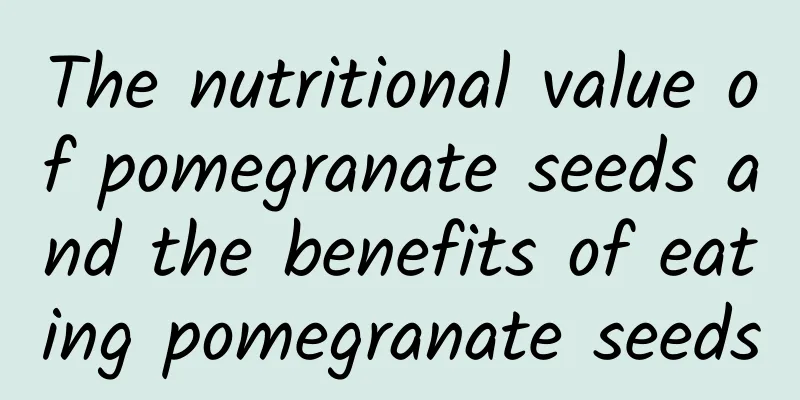The nutritional value of pomegranate seeds and the benefits of eating pomegranate seeds

|
Pomegranate is the fruit of the plant Punica granatum of the Punica family. It is produced in most areas of my country. The best ones are large, red and yellow, and sweet and sour. Pomegranate is a strange berry. The outer seed coat is translucent and juicy; the inner seed coat is leathery. Pomegranate IntroductionPomegranate is the fruit of the plant Pomegranate, which belongs to the family Punica granatum. It is native to the Western Regions and was introduced to my country during the Han Dynasty. There are mainly different varieties such as agate pomegranate, pink pomegranate, green pomegranate, and jade pomegranate. The skin of mature pomegranate is bright red or pink, and often cracks, revealing crystal-like gemstones. It is sweet and sour and juicy. Although it is troublesome to eat, it is endless aftertaste. Because of its bright color and plump seeds, it is often used as a festive fruit, symbolizing many children and a large family. Pomegranates mature during the Mid-Autumn Festival and National Day, and are a festive and auspicious gift for relatives and friends. Pomegranates can eliminate menopausal disorders in women. Pomegranates are sour, sweet, astringent, and warm in nature, and enter the kidney and large intestine meridians. Pomegranate fruits are rich in organic acids, vitamins C and B, as well as protein, fat, and minerals such as calcium, phosphorus, and potassium. The fruit, peel, root and flower of pomegranate can be used as medicine. The medicinal fruit is mostly sour, which has the effect of astringing the intestines and stopping bleeding. The peel contains tannins, alkaloids and ursolic acid, which have obvious astringent and antibacterial effects and are a powerful medicine for treating dysentery. The root bark contains pomegranate peel alkaloids, which is an important anthelmintic and is also effective in treating kidney stones, diabetes and chyluria. The flower can stop bleeding and leucorrhea, and can also be used to soak water and wash eyes, which has the effect of improving eyesight. In addition, pomegranate seed oil has estrogen-like effects. Nutritional value of pomegranate seedsPomegranate seed polyphenol extracts are powerful antioxidants that help improve joint strength and skin elasticity and strengthen arteries, veins and capillaries. Anti-inflammatory effects have also been reported in arthritis and sports injuries. Eye diseases such as diabetic retinopathy (inflammation of the retina due to diabetes) and vision loss may also benefit from it. 1. Enhance capillary activity and strengthen capillary walls By helping to protect the arterial lining from the buildup of mutants that can cause cardiovascular disease, pomegranate seed polyphenols may help strengthen blood vessel walls and improve circulation, which is especially important for stroke patients, diabetics, arthritis, smokers, women taking oral contraceptives, and those with leg swelling and edema (an abnormal amount of fluid accumulation in the leg tissue). 2. Improve skin smoothness and elasticity Collagen is the main protein found in the skin and is closely related to skin texture. Pomegranate seed polyphenols can help protect the skin from damage by free radicals and collagen-degrading enzymes. This protective effect may help prevent the formation of premature skin wrinkles due to loss of skin elasticity. In many European countries, women take pomegranate seed polyphenols as a supplement to prevent wrinkle formation and help keep the skin smooth and elastic. 3. Reduce diabetic retinopathy and improve vision Diabetes is prone to cause arterial weakness and can affect the retina. Pomegranate seed polyphenols have been used for many years to treat diabetic retinopathy and improve vision. 4. Reduce varicose veins By reducing arterial fragility, pomegranate seed polyphenols may help prevent bruising and the possible formation of varicose veins. 5. Helps improve brain function Pomegranate seed polyphenols may be important for brain function, not only because of their protection of blood vessels, but also because they are one of the few dietary antioxidants that may cross the blood-brain barrier to directly protect brain cells. Strengthening capillaries and other blood vessels may help prevent strokes. Scientists speculate that their protection of brain cells may help preserve memory and reduce the effects of aging. There are signs that even dormant memory may be improved with better circulation and cell nutrition. It is possible that in |
<<: How to eat durian and its nutritional value
>>: What are the nutritional values of pomegranate seeds?
Recommend
How to grow chives? Techniques for growing chives in greenhouses
We have learned a lot about leeks, and we can als...
The benefits of eating wild rice stem
Have you ever eaten wild rice? Do you know what i...
How is Molex? Molex reviews and website information
What is Molex? Molex is a leading global supplier ...
Steps to make hawthorn cake
Hawthorn is a common fruit in our lives. It not o...
What is Harrow School like? Harrow School reviews and website information
What is Harrow School? Harrow School is a famous p...
How to eat carambola? The efficacy and function of carambola
Star fruit is a fruit produced in tropical region...
The efficacy and function of Chinese yam and the method of eating Chinese yam
Chinese yam is rich in protein, vitamins and amin...
The benefits of eating black wolfberry
Black wolfberry is a well-known health food recen...
What to do if the leaves of Clivia turn yellow
Clivia is a kind of flower plant that many people...
The benefits of grapefruit juice
In addition to being used as an ingredient in coo...
The efficacy and function of bean sprouts
Bean sprouts are a dish that everyone has eaten. ...
How to make delicious green beans? How to make green beans step by step tutorial
Kidney beans are a common food and a type of vege...
How is Nippon Travel Agency? Reviews and website information of Nippon Travel Agency
What is Nippon Travel Agency? Nippon Travel Agency...
How is the Equatorial Guinea Gazette? Reviews and website information of the Equatorial Guinea Gazette
What is the website of La Gaceta de Guinea Ecuator...
The efficacy and function of lentils
Lentils have many aliases, including mung beans, ...









